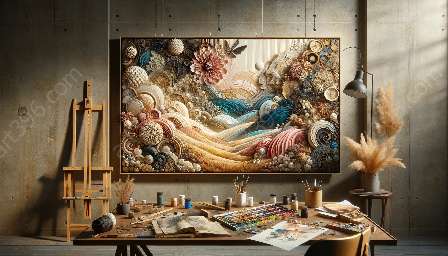Mixed media art has gained significant popularity in the contemporary art world due to its versatility and ability to convey complex narratives and emotions. Combining various materials and techniques, artists create unique and compelling works that challenge traditional artistic boundaries.
As mixed media art continues to captivate audiences and gain recognition in the art market, ethical considerations in collecting and displaying such artworks have become increasingly important. The intersection of history, practice, and ethical dilemmas raises critical questions about the responsibilities of artists, collectors, and curators in the presentation of mixed media art.
History of Mixed Media Art
The history of mixed media art can be traced back to as early as the 20th century when artists began experimenting with unconventional materials and techniques to create artworks that defied traditional categorization. The Dada movement, known for its anti-art approach and use of found objects, played a significant role in shaping the foundations of mixed media art.
Throughout the 20th century, artists such as Robert Rauschenberg and Jasper Johns further expanded the possibilities of mixed media by integrating everyday objects and incorporating alternative processes such as collage, assemblage, and as well as exploring the intersections of painting and sculpture.
By the late 20th and early 21st centuries, mixed media art had firmly established itself as a prominent and diverse genre within contemporary art. Artists embraced new technologies and materials, blurring the boundaries between different artistic disciplines and creating immersive and thought-provoking experiences for viewers.
Ethical Considerations
When it comes to collecting and displaying mixed media art, ethical considerations come into play at various stages, encompassing the creation, acquisition, and presentation of artworks. Artists, collectors, and curators alike are confronted with complex ethical dilemmas that have significant implications for the interpretation and preservation of mixed media artworks.
Artist Responsibilities
Artists working with mixed media face ethical considerations related to the sourcing and repurposing of materials. The use of found objects and unconventional materials raises questions about the ethical implications of appropriation, cultural sensitivity, and environmental impact. Artists must navigate the ethical complexities of upcycling and repurposing materials, ensuring that their creative process is respectful and responsible.
Collector Responsibilities
For collectors of mixed media art, ethical considerations extend beyond the acquisition of artworks. The decision to collect and display mixed media pieces involves a careful assessment of the artist's intentions, the historical context of the work, and the ethical implications of ownership. Collectors must consider the ethical ramifications of supporting artists and artworks that engage with politically sensitive or controversial subject matter.
Curatorial Responsibilities
Curators play a pivotal role in shaping the public's engagement with mixed media art through exhibition design and interpretation. Ethical considerations in curation encompass issues of representation, inclusivity, and cultural sensitivity. Curators must navigate the ethical challenges of presenting mixed media artworks in a way that respects diverse perspectives, while also addressing potentially contentious themes and narratives.
Challenges and Responsibilities
The growing prominence of mixed media art presents a range of challenges and responsibilities for artists, collectors, and curators. The fluid and interdisciplinary nature of mixed media artworks requires thoughtful engagement with the ethical dimensions of creation, collection, and exhibition.
Artists are tasked with balancing creative freedom with ethical considerations, navigating the complexities of material usage and cultural references. Collectors are responsible for understanding and contextualizing the artworks they collect, acknowledging the ethical implications of their acquisitions and their impact on the broader art ecosystem. Curators bear the responsibility of presenting mixed media art in a manner that is both ethically informed and intellectually engaging, fostering critical dialogue and ethical reflection among diverse audiences.
Conclusion
As mixed media art continues to evolve, ethical considerations remain integral to its creation, collection, and presentation. The history of mixed media art provides a rich context for exploring the ethical dimensions of contemporary artistic practice. By considering the responsibilities of artists, collectors, and curators, we can cultivate a nuanced understanding of the ethical challenges and opportunities embedded within the world of mixed media art.

